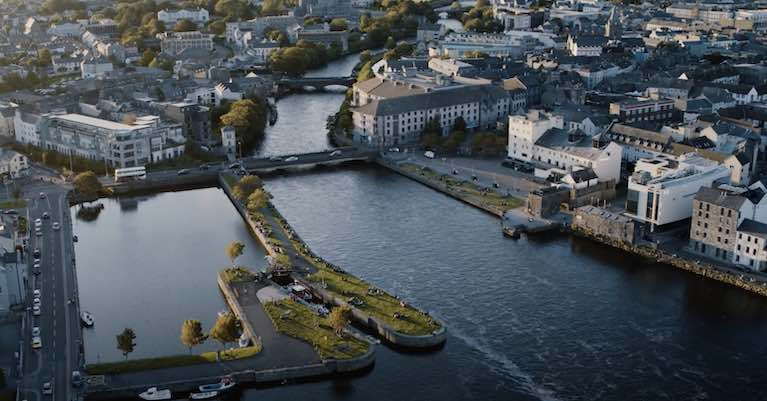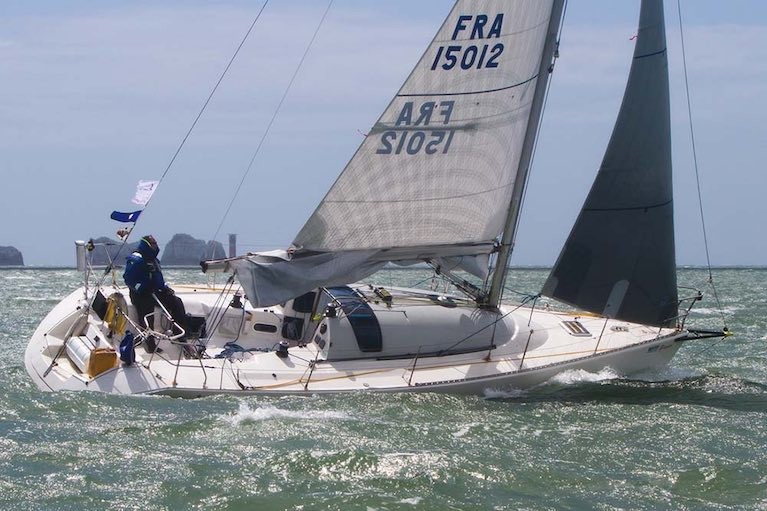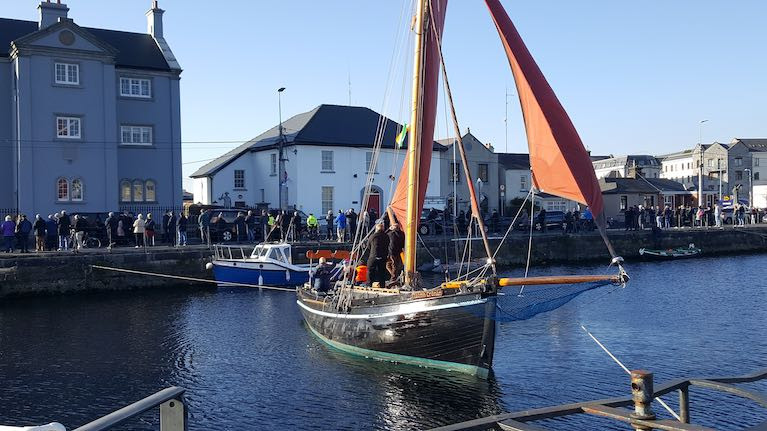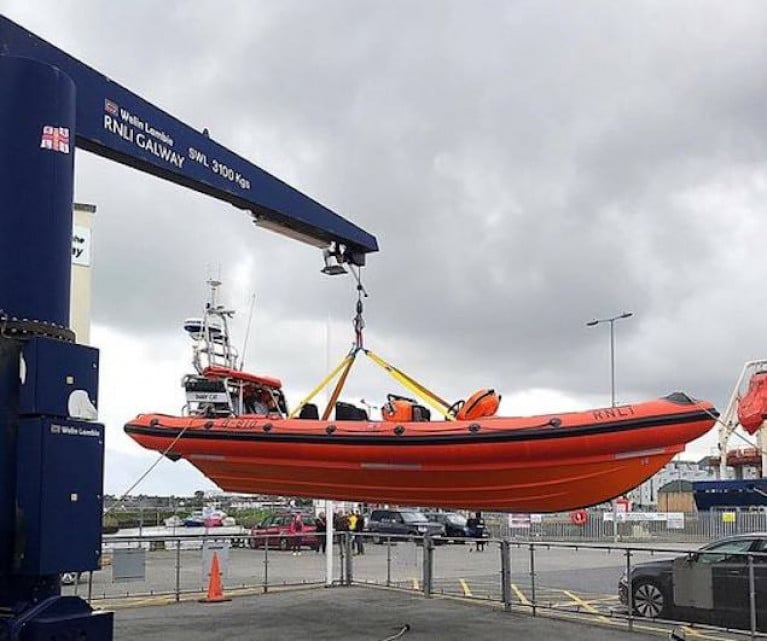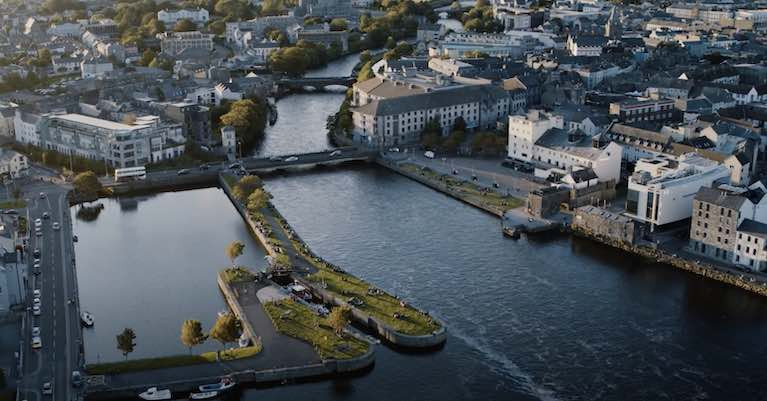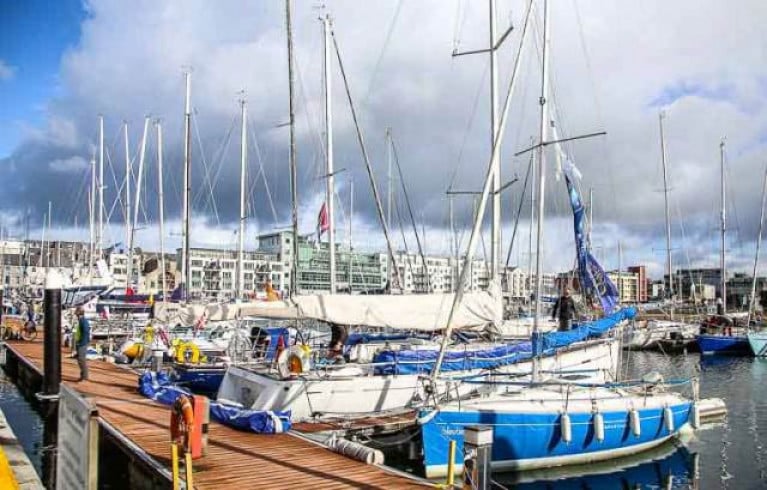Displaying items by tag: Galway Harbour
St Patrick’s festival is being marked with an illuminated gleoiteog in Galway’s Claddagh basin this week.
The gleoiteog Manuela has been decorated with lights by Bádóirí an Cladaig, the city association dedicated to training and restoration of the traditional craft.
The vessel was named in memory of Manuela Riedo, the Swiss student who was raped and murdered in Galway in October 2007
Bádóirí an Cladaig also illuminated several of its fleet of traditional vessels in the Claddagh basin over Christmas and new year, raising spirits during the pandemic.
Almost two years ago, the training organisation launched The Lovely Anne, a 137-year-old workboat built-in 1882 by boat-wright, Patrick Brannelly.
Brannelly also built An Tónaí and the Morning Star.
After being part of the local hooker fleet in the early 1900s, the vessel was sold over 46 years ago to Jim Parkinson, who fished it for many years.
Voyagers from the Grave: A Claddagh Calamity of 1876
“Voyagers from the grave” read the headline in a Melbourne newspaper, The Advocate, in 1877, and the report was about three Galway men who had by then become known as “the shaughrauns”.
The previous November of 1876, four men, had set out to fish from the Claddagh in a hooker, named Saint Patrick.
In the words of the skipper, Michael Moran, he and his crewmen Michael Smith, Patrick Moran, and his uncle John Moran, made for Slyne Head, about sixty miles from Galway.
That night a tremendous storm carried the vessel 150 miles out into the Atlantic, where four days later, three survivors were rescued by a passing Swedish vessel and taken to America.
“We had no extra good fortune, and at night foggy weather overtook us. The wind sprung up, blowing a perfect hurricane. My post was at the helm where my hands became frozen. On Tuesday night the boat was half-filled with water,” skipper Moran recalled.
“It is our custom to light turf on setting out and keep the fire going. The water put it out. Although we had potatoes and fresh fish, we had no means to cook them,” he said.
“We were four days and four nights without eating. In order to break the speed with which we were driven, we lowered a basket filled with stones and endeavoured to heave to but the cable broke on Friday morning,” he said.
That same morning, they woke to find no trace of the oldest man on board, his uncle John Moran.
NUI Galway lecturer in history Dr John Cunningham has researched the “Claddagh calamity”, and he gave a recent online talk to the Galway Archaeological and Historical Society about what happened, and how the men were given up for dead and were "waked".
Dr Cunningham is a committee member of the Galway Archaeological and Historical Society, a member of the editorial board of its journal, and a past editor of Saothar: Journal of Irish Labour History. He is co-editor with Ciaran McDonough of a forthcoming volume commemorating the bicentenary of James Hardiman's history of Galway – Hardiman and Beyond: Arts and Culture in Galway, 1820-2020 which is due for publication in April.
Dr Cunningham spoke to Wavelengths about his findings, and first of all, describes the vessel which the four men set sail in from the Claddagh.
You can hear the Wavelengths interview below
And you can see the full lecture by Dr Cunningham here
Galway City Council has accused An Taisce of “greatly exaggerating” pollution claims and believes a new sensor measuring wastewater discharge into Galway Bay will prove the environmental group wrong.
As reported by Times.ie today, this follows an estimate by An Taisce that over 30 Olympic swimming pools full of pollution is being discharged monthly into the river Corrib and bay.
City councillors have been told this week that a new “level sensor/event monitor” installed at Long Walk overlooking the Claddagh in September will make an “informed estimate”.
It is one of a series of measures being undertaken by Galway City Council and Irish Water, councillors were told.
An Taisce’s report, which was recently submitted to both Galway City Council and the Environmental Protection Agency (EPA), drew an angry reaction last month from the local authority.
A seven-page report issued by Galway City Council this week says it is “not discharging raw sewage from foul sewers into Galway Bay”.
It also says there is “no issue” with the Mutton island waste water treatment plant which is monitored by the EPA.
It says that it is working with Irish Water to deal with “issues” associated with two of the city’s beaches to “improve their status”.
Galway City Council says that “all known discharges are reported to the EPA”.
It also points out that the city has four designated bathing areas over 10km of coastline, with two having Blue Flag and Green Coast status and says their protection is of the “utmost importance”.
Read more on Times.ie here
Galway Port is Round Britain & Ireland Race Stopover for 2022
Galway Bay Sailing Club in conjunction with The Royal Western Yacht Club (Plymouth) has announced that Galway Port has been selected as a stopover port for The Round Britain and Ireland Race in 2022.
This classic Round Britain and Ireland race which will be entering its 56th year will see over 40 boats competing in various classes over a three week period in May 2022. Starting in Plymouth, The Round Britain and Ireland Race has compulsory stopovers in Galway, Lerwick, and Blyth before finishing back in Plymouth.
Acting Rear Commodore Oceanic and Race Director, Adrian Gray said, “We are excited to announce the new format for this classic, well-known race. We are also delighted to announce our new stopover host, the Galway Bay Sailing Club, where we are assured to receive a very traditional Galway Céad Míle Fáilte”
 The Round Britain and Ireland race sees an amazing assortment of yachts taking part.
The Round Britain and Ireland race sees an amazing assortment of yachts taking part.
Galway and the Galway Bay Sailing Club are no strangers to hosting International Sailing events, having previously hosted the 2005 and 2009 Volvo Ocean Race stopovers.
Galway is also the spiritual home of the Green Dragon Irish entry in the race is perfectly placed on The West Coast of Ireland to provide a welcome respite before taking on the leg to the Shetland Isles.
Johnny Shorten, Commodore of Galway Bay Sailing Club commented, "We are proud and excited to be hosting the Round Britain and Ireland's race's stopover for the first time. A warm welcome and great Craic is awaiting all involved during the first stopover of the event. We hope it will be the first of many”.
 Galway Docks is used to welcoming visiting fleets to the West Coast including the ICRA cruiser-racer fleet (above) in 2018 Photo: Afloat
Galway Docks is used to welcoming visiting fleets to the West Coast including the ICRA cruiser-racer fleet (above) in 2018 Photo: Afloat
Galway Harbour Master, Captain Brian Sheridan said he was delighted that the Port of Galway had been successfully selected as a stopover in the RB&I Race in 2022. “We are no strangers is hosting major maritime events and we look forward to rolling out the ‘blue’ carpet when competing yachts arrive in Galway bay for what I am sure will be a very successful race”.
The race is a combination of competitive sailing and enjoyable social gatherings. The course, around all the islands of Britain and Ireland except the Channel Islands and Rockall, can be a severe test of navigation and seamanship in the heavy weather that is often experienced. By contrast, the hospitality shown by the host Yacht Clubs and communities in the four stopover ports, in which the competitors must spend at least 48 hours, can be much more enjoyable and often just as exhausting.
Galway Bay Sailing Club, comfortably ensconced in their fine clubhouse at Renville New Harbour near Oranmore at the head of Galway Bay, can look back at many ups and downs during the fifty years of sailing development they've experienced from small beginnings in the city in 1970, until now they're one of the pre-eminent clubs on the West Coast in all areas of sailing.
Yet even the most sadistic theatrical director would scarcely have green-lighted a storyline in which – just as the final details for a year's long Golden Jubilee celebration in 2020 were being put into place by Commodore John Shorten and his committee – the Black Beast from the East, otherwise the Pandemic, crept into place to dominate everyone's lives and blast lovingly-crafted programmes into smithereens.
 Work in progress? Galway Bay SC's very effective and hospitable clubhouse at Rinvillle may have looked like "job finished" for this year's Golden Jubilee, but Commodore John Shorten and his Committee are fund-raising for further developments
Work in progress? Galway Bay SC's very effective and hospitable clubhouse at Rinvillle may have looked like "job finished" for this year's Golden Jubilee, but Commodore John Shorten and his Committee are fund-raising for further developments
But they're a determined lot in Galway. And though initially, their main concern was that their ocean-voyaging heroes, the Quinlan-Owens family on the 43ft steel ketch Danu, should get safely home to Galway from lockdown confinement in the Caribbean, when Danu finally made port in Kilronan in the Aran Islands after a notably successful visit to the Azores during their return from the Americas, the sailors of Galway Bay were carving a season of sorts out of the times that are in it.
In fact, one of the club's most noted members, Aodhan FitzGerald - who has been both the holder (with Galwegian-by-adoption Yannick Lemonnier) of the two-handed Round Ireland Record for 14 years, while also winning the 2008 Round Ireland Race outright) has confided that the gentler pace of the permissible sailing of 2020 actually had its own special enjoyment, and the atmosphere around the club during summery evening training sessions acted as a welcome pressure-release valve for all who took part.
As for Danu's return, it so happened that a socially-distanced cruise-in-company to Inishbofin, co-ordinated by Cormac Mac Donncha (who organised last year's hugely successful Cruise-in-Company to Lorient in South Brittany) was getting under way with Kilronan the second stop as the August weekend approached, and by purest serendipity Danu got the welcome home she so richly deserved before her gallant crew had even entered the inner waters of Galway Bay.
 Danu in the Caribbean last winter. Her escape from "pandemic prison" was celebrated with GBSC fellow-members in socially-distanced style in Kilronan
Danu in the Caribbean last winter. Her escape from "pandemic prison" was celebrated with GBSC fellow-members in socially-distanced style in Kilronan
Thus like other clubs, GBSC made the best of it afloat and ashore during 2020. But Golden Jubilees being something special, last Friday night they organised a combined Zoom session and socially-distanced clubhouse gathering to honour those who have contributed to Galway sailing for fifty years and more, and they did it so cleverly that they managed to drop a surprise Lifetime Achievement Award on Pierce Purcell totally out of the blue, as he thought he was there for something else altogether.
In a speech of appreciation of Pierce's unrivalled contribution – which pre-dates 1970 – fellow long-server Aonghus Concannon made it clear just how much GBSC and Galway Bay sailing and maritime life generally owe to Pierce Purcell's boundless enthusiasm and total generosity with his time. That said, those of us who know him rather doubt that "Lifetime Achievement" hits the target – "Successful Mid-Term Assessment" might be more appropriate……
 Caught on the hop – Aonghus Concannon (left) looking properly pleased after his surprise announcement of the Lifetime Achievement Award to Pierce Purcell (right) had gone exactly according to plan
Caught on the hop – Aonghus Concannon (left) looking properly pleased after his surprise announcement of the Lifetime Achievement Award to Pierce Purcell (right) had gone exactly according to plan
Other speakers (both in person and electronically) and awardees in a ceremony hosted by Andrew Drysdale with music by Lir O'Dowd included John Killeen the Chair of the Marine Institute, Galway Harbour Master Brian Sheridan, former Commodore and noted offshore racer Donal Morrissy, Pierce Purcell Jnr, Fergal Lyons, Dave Brennan, Pat Irwin, Conor Owens, Tom Foote, Vera Quinlan who received the premier cruising award, Pat Ryan and Yannick Lemonnier.
This unusual but successful ceremony was brought to a conclusion by Commodore Johnny Shorten, who in best Commodorial style congratulated the many recipients, and in talking of what the club has done and achieved in fifty years, neatly reminded everyone that no club ever thrives by standing still. He and his Officers and Committee have interesting plans for further development, and GBSC recently opened a GoFundMe page to help get the resources in place.
 GBSC Commodore Johnny Shorten reminds the members that the best way to celebrate a club's Golden Jubilee is through worthwhile plans for the future
GBSC Commodore Johnny Shorten reminds the members that the best way to celebrate a club's Golden Jubilee is through worthwhile plans for the future
 Isobella Irwin winning the Junior Female Sailor of the MidShipMan award at the Galway Bay Sailing Club presented by Johnny Shorten Commodore and Pat Irwin of Galway Bay Sailing Club
Isobella Irwin winning the Junior Female Sailor of the MidShipMan award at the Galway Bay Sailing Club presented by Johnny Shorten Commodore and Pat Irwin of Galway Bay Sailing Club
 Rory Collins winner of the Junior Male Sailor awarded the MidShipMan award presented by Johnny Shorten Commodore and Pat Irwin Galway Bay Sailing Club
Rory Collins winner of the Junior Male Sailor awarded the MidShipMan award presented by Johnny Shorten Commodore and Pat Irwin Galway Bay Sailing Club
 Pat Ryan presented with the Michael Donohue Memorial Trophy for Volunteer of the year by Johnn Shorten Commodore and Captain Brian Sheridan Harbour Master at the Port of Galway
Pat Ryan presented with the Michael Donohue Memorial Trophy for Volunteer of the year by Johnn Shorten Commodore and Captain Brian Sheridan Harbour Master at the Port of Galway
 Vera Quinlan (Director of Cruising Irish Sailing Association) and Peter Owens (boat Danu) won the David Baynes Cruising Award for the best log. Presented by Johnn Shorten Commador Galway Bay Sailing Club 50th - Anniversary Awards
Vera Quinlan (Director of Cruising Irish Sailing Association) and Peter Owens (boat Danu) won the David Baynes Cruising Award for the best log. Presented by Johnn Shorten Commador Galway Bay Sailing Club 50th - Anniversary Awards
 Pierce Purcell - Lifetime Achievement Award presented by Johnny Shorten Commador of the Galway Bay Sailing Club and Aonghus Concannon
Pierce Purcell - Lifetime Achievement Award presented by Johnny Shorten Commador of the Galway Bay Sailing Club and Aonghus Concannon
 Fergal Lyons presenting Cian and Rian Baynes of Joker, winners of the Oyster Festival Race Galway Bay Sailing Club
Fergal Lyons presenting Cian and Rian Baynes of Joker, winners of the Oyster Festival Race Galway Bay Sailing Club
 Fergal Lyons presenting Liam Burke, Tribal receiving the Spring Cup - Galway Bay Sailing Club 50th - Anniversary Awards night.
Fergal Lyons presenting Liam Burke, Tribal receiving the Spring Cup - Galway Bay Sailing Club 50th - Anniversary Awards night.
Funeral of Oliver Family Father & Son Brings Galway to a Standstill
When the funeral of Galway fishermen Martin and Tom Oliver left Claddagh church yesterday, the silence among hundreds of people lining the route was broken only by the roar of the river Corrib and the gentle sound of wind in canvas sails.
Three Galway Hookers had moored in the Claddagh Basin, with musician Sharon Shannon on board the deck of one of the vessels playing soft airs on her accordion.
 Three Galway Hookers moored in the Claddagh Basin
Three Galway Hookers moored in the Claddagh Basin
Martin, who was almost 62, and his son Tom (37) died within 24 hours of each other after a fishing accident on their potting vessel on the north side of Galway Bay last Monday.
Mayor of Galway Mike Cubbard, who opened a book of online condolences, paid tribute to the two men as “salt of the earth” and “the best of friends”.
He noted that it was only a few weeks since he had recognised the role of Martin’s relatives, Patrick and Morgan Oliver, in rescuing two paddleboarders, Sara Feeney and Ellen Glynn, in Galway Bay last August after 15 hours at sea.
Several generations of the Oliver family have been associated with the lifeboat service, and members of the RNLI and the fishing communities along the coast and on the Aran islands travelled to pay their respects.
Galway RNLI volunteers and members of the Galway Sea Scouts formed a guard of honour outside the church, where a private Mass was celebrated by Fr Gerry Jennings of Salthill parish, assisted by Fr Donal Sweeney of the Claddagh’s Dominican community.
Afterwards, Martin’s daughter and Tom’s sister Susanne and her mother Eileen were consoled by many friends, and relatives, as the city centre came to a standstill and construction work stopped as a mark of respect.
Crew with Badóirí an Cladaigh and the Galway Hooker Sailing Club had rigged the gleoiteog Manuela - named after the late Swiss student Manuela Riedo - along with the leath-bhád Croi an Cladaigh, and the bád mór Naomh Crónán in full sail in the Claddagh basin.
A Garda escort led the cortege over Wolfe Tone bridge and around by Long Walk and into Galway docks, as people lined both sides of the streets.
Two orange flares were released on the water surface, and members of Galway Bay Sailing Club then lit hand-held flares on the dockside, where State research ship Celtic Voyager and a number of fishing and angling vessels were berthed.
 Flares were lit and harpist Úna Ní Fhlannagáin (left) played at Galway Docks
Flares were lit and harpist Úna Ní Fhlannagáin (left) played at Galway Docks
The rich chords of harpist Úna Ní Fhlannagáin resonated as members of the Oliver and Griffin families cast flowers at the water’s edge in bright sunshine.
The cortege paused for a few moments at the docks, and more tears were shed before the two hearses continued up to Rahoon cemetery overlooking the city. In the graveyard, the father and son – who had been inseparable in life - were buried side by side.
Galway harbourmaster Brian Sheridan said it was a “profoundly sorrowful tragedy for the Oliver family, and the wider fishing community”.
Book of Condolences for Oliver Family
Galway City Council has opened an online book of condolences for Martin and Tom Oliver, the father and son who died after a fishing accident in Galway Bay earlier this week.
Tom Oliver (37) was pulled overboard their vessel on Monday afternoon while working on pots on the north side of Galway Bay west of Salthill. His father, Martin, raised the alarm, and Galway RNLI was tasked to the scene by the Irish Coast Guard.
Lifeboat crew administered CPR en route to Galway docks and Tom Oliver was taken by ambulance to University Hospital, Galway but did not survive.
Martin Oliver (62) died early on Tuesday morning. Both men were from a well known and highly experienced fishing family from the Claddagh area of Galway.
Mayor of Galway Mike Cubbard said that a “dark cloud hangs over the city as the sudden departure of two gentlemen has left a void in the lives of so many.”
“Rest in peace, Martin and Tom Oliver, you will be sorely missed by so many near and far. My deepest sympathies to their families at this sad time," Mayor Cubbard said.
The online book of condolences will remain open for a week until November 11th here
Galway Marine Community in Shock Over Fisherman's Death
The Galway fishing and wider marine community is in shock over the death of a young fisherman from a well known Claddagh family on Monday afternoon.
The fisherman, whose name has not yet been released, was working on the deck of his father’s vessel when he was thrown overboard.
As Afloat reported earlier, the vessel was working on pots between Blackrock and Silver Strand on the north side of Galway Bay when the incident occurred.
There was a light swell at the time, but visibility was good. The alarm was raised at lunchtime and the Irish Coast Guard tasked the Galway inshore lifeboat.
Upon arrival, the lifeboat crew took the casualty on board and administered cardiopulmonary resuscitation en route to Galway docks. The young man was then transported by ambulance to University Hospital, Galway.
The lifeboat crew were helmsman Martin Oliver, Brian Niland, Lisa McDonagh and Declan Killilea.
Galway's Claddagh Quay Venue for "Mirror Pavilion"
Galway’s Claddagh Quay is the location for a 24-hour digital art exhibit which has been weather-proofed for the Atlantic elements.
Climate crisis is the theme of “Mirror Pavilion”, which was designed by John Gerrard as Galway 2020 European cultural capital commission.
Galway International Arts Festival (GIAF) engaged Gerrard, an award-winning Irish international artist known for his site-specific work, and he has spent the last two years on the project.
 John Gerrard's Mirror Pavilion Photo: Colm Hogan
John Gerrard's Mirror Pavilion Photo: Colm Hogan
Entitled “Corn Work”, the exhibit will recall the history of grain milling on one of Europe’s fastest flowing rivers for its short length.
The seven-metre cubed structure is clad in a highly reflective mirror on three sides, while a fourth high resolution LED wall displays a series of digitally created and choreographed characters.
Named the Straw Boys, the figures perform a “symbolic wheel of production”.
The “Mirror Pavilion” is a free, non-ticketed event, running at the Claddagh until September 26th.
It aims to provide a mirror image to “Leaf Work”, another virtual world created by Gerrard for the pavilion in a second location - Derrigimlagh bog in Connemara - from October 11th to 31st.
Derrigimlagh Bog was the transmission site for the first transatlantic radio signal from the Marconi station in 1907, and landing place for Alcock and Brown’s first-ever transatlantic plane crossing in 1919.
The Connemara exhibit is billed as a “response to the solar cycle and changing temperatures, their movements in tandem with the changes of the seasons”.
The “Mirror Pavilion” will be “presented within, and cognisant of, Government Covid-19 guidelines”, GIAF states.
Compliance with the guidelines, social distancing and limited attendance is also emphasised for Galway 2020’s re-imagined programme from September to next March.
As part of the 2020 programme, seven artists, writers and composers from across Europe have produced a series of standalone artworks for exhibition and radio broadcast, entitled Aerial/Sparks.
The artwork was inspired by participation in research expeditions onboard the Marine Institute Ireland’s RV Celtic Explorer.
Galway City Museum is hosting a multi-disciplinary exhibition relating to archaeology, architecture, cultural landscapes associated with islands, including “never-before-seen material” from the 1990s archaeological excavations at Dún Aonghasa on the Aran island of Inis Mór.
Artist John Gerrard will speak to GIAF artistic director Paul Fahy in a live-streamed event from Galway City Museum at 6 pm on Thursday, September 3rd.
Marinas and public slipways around the coast are due to open next week as part of a phased lifting of Covid-19 restrictions.
Port of Galway harbourmaster Capt Brian Sheridan has said the port’s public slipway and its marina will be open to those living within five kilometres.
Sailing is permitted within HSE guidelines, once landing ashore is not beyond five kilometres of a boat owner’s primary residence.
However, no visiting leisure craft are permitted to enter the marina under procedures drawn up to match HSE Covid-19 guidelines.
Hand sanitisers have been installed at the marina gangway, social distancing must be observed and any boat owners requiring the crane for boat lifts will have to complete a self-declaration of health, Capt Sheridan has said.
Galway City Council has opened up beaches, but car parks at all but Silver Strand remain closed.
Bathing water quality testing won’t begin until June 1st. Blackrock Diving Tower in Salthill remains closed until June 8th, when there will be restricted use. Salthill’s promenade will re-open with social distancing.
Galway City Council is also establishing a “city mobility team” to examine “wider footpaths, safer cycling facilities, traffic restrictions and supporting businesses who may need the use of public space for social distancing purposes”.
The Government has sanctioned re-opening of “outdoor public amenities and tourism sites, such as car parks, beaches and mountain walks” as part of phase one from Monday, May 18th.
This weekend the Irish Coast Guard lifted its advisory on staying off the water but urged people to observe the “current 2x5 rule, as in two-metre physical distance and five km travel distance”,
Irish Coast Guard spokesman Gerard O’Flynn thanked the public for its co-operation and warning that that there is still a Government focus on protection of frontline services and saving lives.
The new Irish Coast Guard statement was not issued with the RNLI, although both bodies issued joint statements over the last month advising people not to take to the water.



























